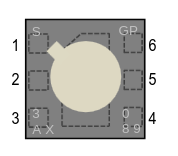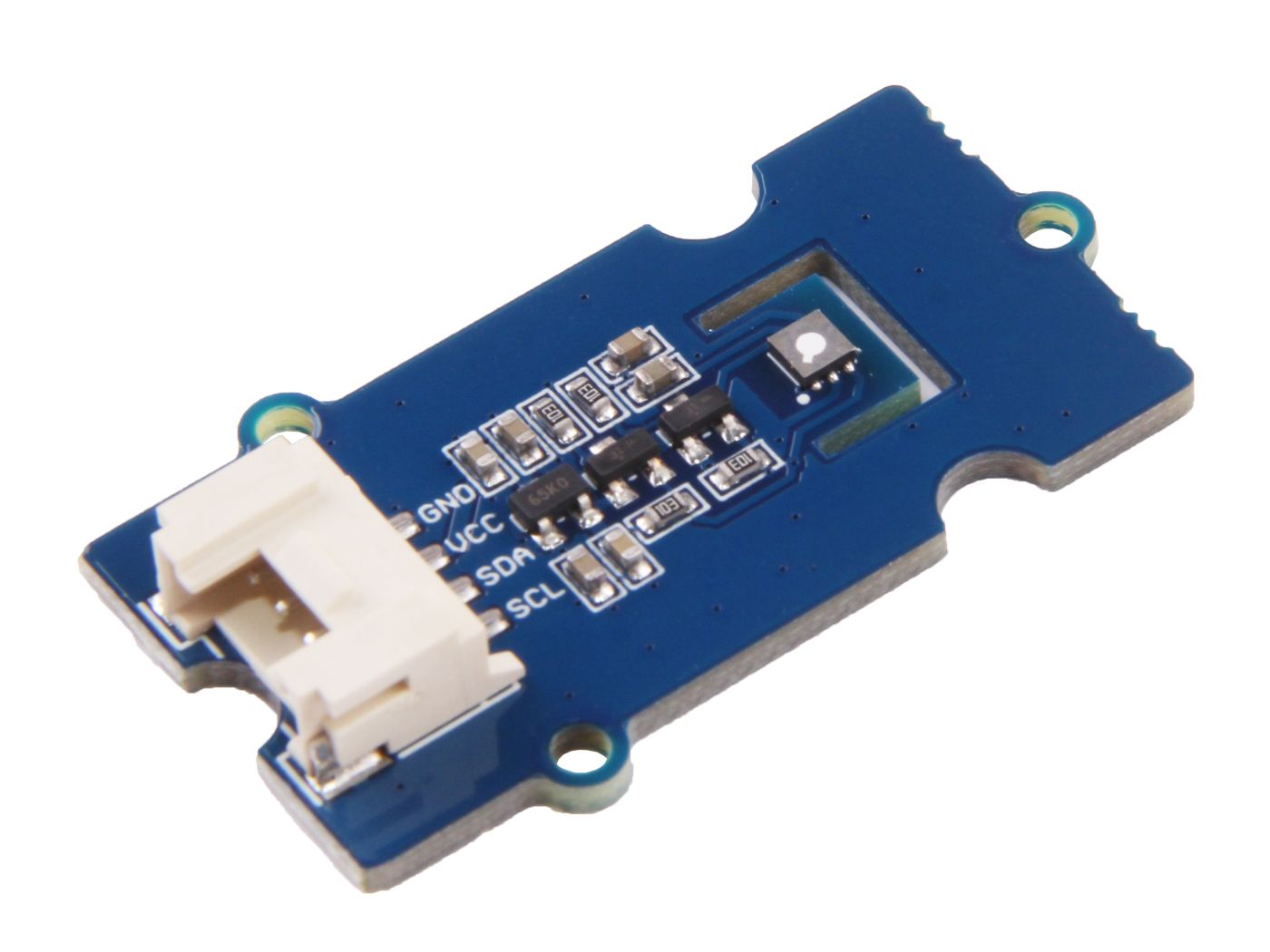SGP30 CO₂ and Volatile Organic Compound Sensor
Overview
| Name | SGP30 |
| Manufacturer | Sensirion |
| Adafruit board | Adafruit SGP30 Air Quality Sensor Breakout |
| Datasheet | Sensirion_Gas_Sensors_Datasheet_SGP30.pdf |
| Infosheet (Adafruit) | adafruit-sgp30-gas-tvoc-eco2-mox-sensor.pdf |
| ESPHome component | sgp30 |
| Interface | |
| I²C address | 0x58 |
| Supply voltage | Sensor: |
Detects and reports (Total) Volatile Organic Compounds and -equivalent levels (calculated from measuring Ethanol and )1.
Working principle
The sensing part (MEMS) of the SGP30 is based on a heated film of metal oxide (MOx) nanoparticles. The gas-sensitive material reacts the oxygen adsorbed on the metal oxide particles with the target gas, thus releasing electrons. This results in a change in the resistance of the metal oxide layer measured by the sensor.
In short, the presence of the reducing gas causes the oxygen concentration on the surface of the gas-sensitive material to decrease, changing the resistance (or conductivity) of the semiconductor. The subsequent detection of the resistance, signal processing and conversion are performed by the circuit (ASIC) section.
Headers
The sensor headers are detailed in the datasheet1, and are as follows:

SGP30 headers
| Header | Name | Description |
|---|---|---|
| 1 | Supply voltage | |
| 2 | Ground | |
| 3 | SDA | I²C SDA data |
| 4 | Connected to ground | |
| 5 | Supply voltage (hotplate) | |
| 6 | SCL | I²C SCL clock |
The datasheet also provides a schematic of the sensor.
Breakout boards
The sensor chip itself is tiny, and different breakout boards are available.
All of the breakout boards listed here have an onboard voltage regulator, and
cand handle both and supply voltages on VIN.
Adafruit SGP30 STEMMA QT/Qwiic
The breakout board has pins for all headers on the sensor. Then VIN pin is
connected to a voltage regulator that converts to for the sensor
and used on the breakout board2.
| Pin | Description |
|---|---|
VIN | Power pin, (connected to voltage regulator). |
1V8 | Connects to on SGP30 sensor. Can supply up to . |
GND | Ground / . |
SCL | I²C SCL clock. |
SDA | I²C SDA data. |
Grove SGP30
This breakout board is larger than the Adafruit board, and also features
a voltage regulator on the VIN pin3.
| Pin | Description |
|---|---|
VIN | Power pin, (connected to voltage regulator). |
GND | Ground / . |
SCL | I²C SCL clock. |
SDA | I²C SDA data. |
GY-SGP30
This breakout board has a very small form factor. There is not much info on it online, and
it's mostly found on Amazon and various eBay stores. It also has an on-board voltage regulator
on VIN that converts to the onboard 4.
| Pin | Description |
|---|---|
VIN | Power pin, (connected to voltage regulator). |
GND | Ground / . |
SCL | I²C SCL clock. |
SDA | I²C SDA data. |
ESPHome
Set up an an I²C bus first.
i2c:
- id: i2c_sgp30
sda: ${gpio_sda}
scl: ${gpio_scl}
And use the sgp30 component5. By default the tvoc
configuration reports TVOC as , but is more standard, so we add a
filter to convert from to .
sensor:
- platform: sgp30
i2c_id: i2c_sgp30
address: 0x58
eco2:
id: sensor_co2eq
name: "CO₂eq"
accuracy_decimals: 1
icon: "mdi:molecule-co2"
device_class: carbon_dioxide
tvoc:
id: sensor_tvoc
name: "TVOC"
accuracy_decimals: 1
icon: "mdi:air-filter"
device_class: volatile_organic_compounds_parts
unif_of_measurement: ppm
accuracy_decimals: 3
filters:
lambda: |-
return x/1000;
eco2_baseline:
id: baseline_ce2eq
name: "Baseline CO₂eq"
tvoc_baseline:
id: baseline_tvoc
name: "Baseline TVOC"
update_interval: 1s
The sensor needs an update_interval of 1s to work reliably (because it operates on cycles)
so by default it's quite noisy and reports a lot of values, so you might want to use some filters
on the sensors6.
Calibration config
store_baseline: The baseline values are persistently stored on the sensor and applied when the sensor boots. Cleared after OTA.baseline: Manually sepecified baseline values.eco2_baseline: Baseline value for sensor.tvoc_baseline: Baseline value for sensor.
compensation: Used to calculate absolute humidity for the sensor to imrove the internal operations of the sensor by calculating absolute humidity.temperature_source: ESPHomeidfor a temperature sensor (reporting in Celsius).humidity_source: ESPhomeidfor a (relative) humidity sensor.
The SGP30 sensor needs to have a calibrated baseline to work accurately, and can calibrate this baseline itself in about 12 hours5.
sensor:
- platform: sgp30
# ...
store_baseline: true
baseline:
eco2_baseline: 0xDEAD
tvoc_baseline: 0xBEEF
# SGP30 is capable of using use external sensor values, this can improve
# it's internal calculations.
compensation:
temperature_source: esphome_temperature_sensor
humidity_source: esphome_humidity_sensor
In order to set the baseline values normally, it's easiest to configure
the eco2_baseline and tvoc_baseline sensors. The sgp30 component needs
the baseline config values to be set in hex (so it probably is parsing the yaml
fields as strings and not integers), so add a filter to get ESPHome to output
hex:
text_sensor:
- platform: sgp30
# ...
eco2_baseline:
id: baseline_ce2eq
name: "Baseline CO₂eq"
icon: "mdi:molecule-co2"
filters:
- lambda: |-
uint16_t baseline = id(baseline_co2eq).state;
std::string hex = esphome::format_hex(baseline);
return PrependFilter("0x").new_value(hex);
internal: false
entity_category: "diagnostic"
tvoc_baseline:
id: baseline_tvoc
name: "Baseline TVOC"
icon: "mdi:air-filter"
filters:
- lambda: |-
int baseline = id(baseline_tvoc).state;
std::string hex = esphome::format_hex(baseline);
return PrependFilter("0x").new_value(hex);
internal: false
entity_category: "diagnostic"
Note that the ids under compensation can come from another sensor onboard (but
the SGP30 has a slight heat generation), or from Home Assistant using the homeassistant
platform.
